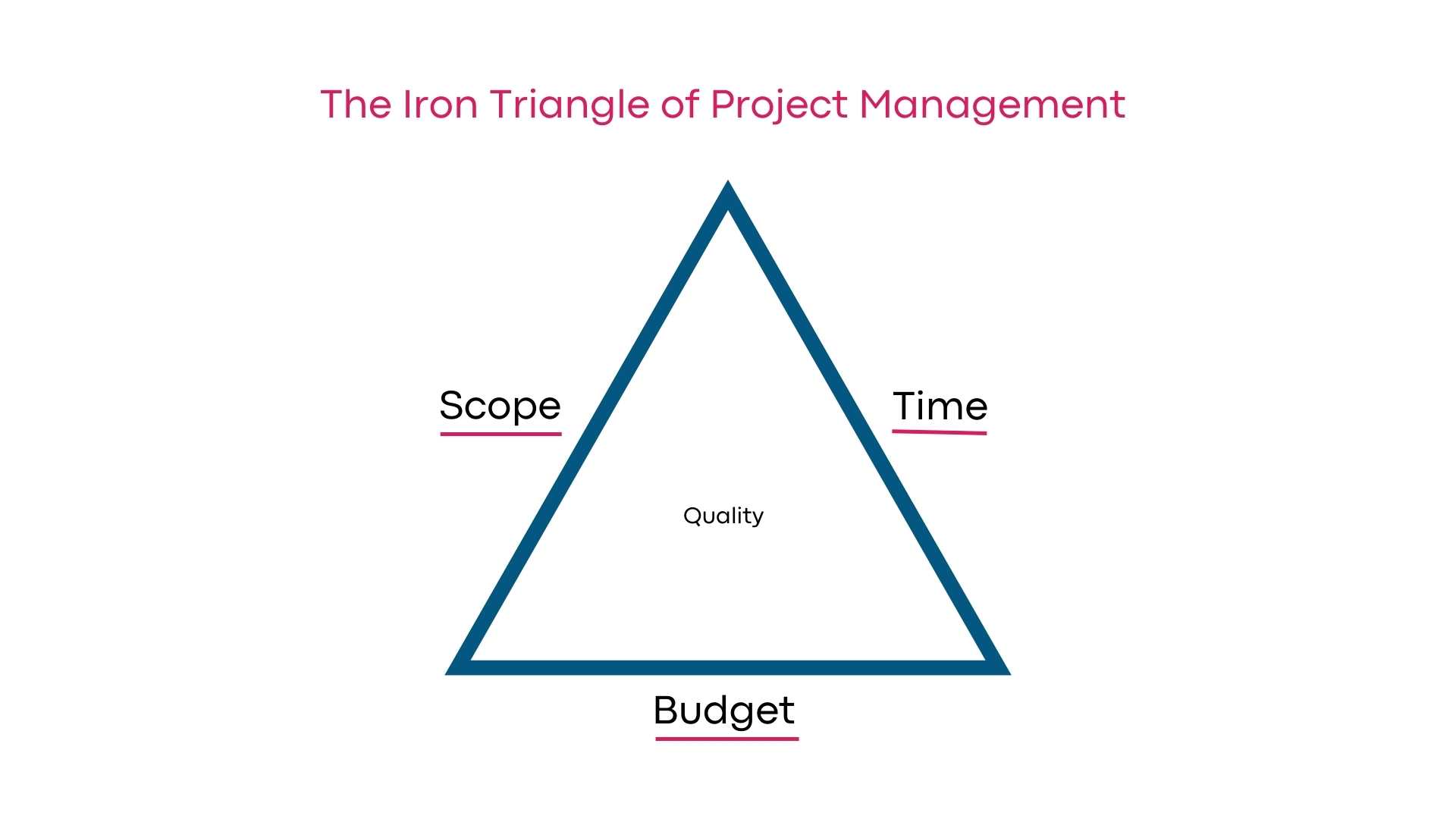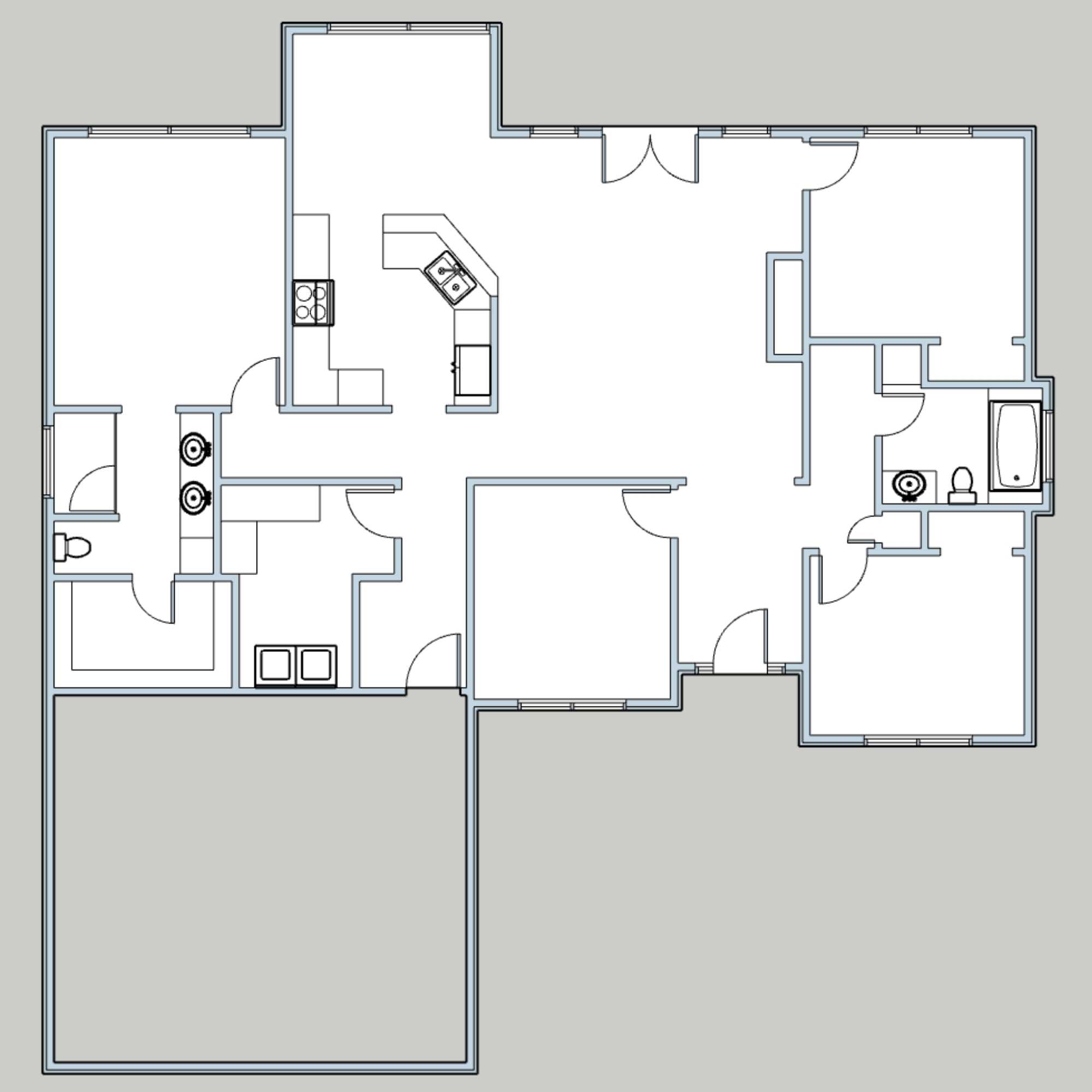
Before we dive into the main lessons I want to share with you, I'm going to give you a bit of background on how I got to be a Project Manager in the first place.
After completing my degree in Marketing and Business Management back in the early 2000s, I did an extra certification in Project Management. I then got my first job in the field and after working enough hours, I was able to write my PMP® exam. PMP stands for Project Management Professional, a program defined and maintained by the Project Management Institute (PMI).
With my formal education and certifications in hand, I thought I was ready to rock and roll. As I started to take on bigger projects, I thought there was very little left to learn. And to be fair, I knew the project management theory very well, and shuddered every time someone referred to a WBS as a “work back schedule”. In PMP language, a WBS is a Work Breakdown Structure, and it's actually a technique for figuring out your project scope that I teach in my Renovation Planning Academy course.
What I didn't know at the start of my career was the people side of project management. Even though I had done a degree in business and worked with like-minded students through countless group assignments, I really didn't understand the dynamics of people, and how different it was to work within a cross-functional team in a business environment.
I assumed everyone was like me—hyper organized, communicative, on top of their work, and good at sticking to deadlines. But what I soon realized was that my peers at school were in my program because they had a similar personality. The people I was managing were entirely different—they were creative, spontaneous, and didn't excel in the same areas as me. Looking back, it shouldn't have been such a rude awakening for me, but it really was. The “people” component was one entire area of study that I never got in my degree or extra PM-specific learning. And as a result, it was the biggest area where I had lots to learn.
The revelations you're going to learn in this article were unfortunately never even shared with me by the more senior PMs guiding me or even my boss. Looking back, I would have appreciated these huge insights early on instead of learning them the hard way. If someone would have sat me down on day 2 of my first PM job and said, “Look...here's the real deal, and it's not what you think.”, it would have been really helpful. Not because it's all good news—but it's the truth.
So I'm going to try to spare you the same learning curve. If you are thinking about renovating your home, then these are the tough-love lessons you're going to need to hear, even though you probably won't want to. But when it's the truth, isn't it better to know either way? Maybe that's too philosophical of a discussion for now, so we'll just stay within the context of renovations, shall we?
To kick us off, here is a blunt truth: YOU are your renovation's chief project manager.
Scared? 😬 Don't be.
Your renovation is a project, and you are both the end client and your own PM in this case. This is not an unusual setup, of course, but it's important to recognize that you are, in fact, playing a distinct role in addition to just being the homeowner. You might be thinking that this is not for you, you're not organized, you have no experience being a project manager, this is now impossible. But wait…before you jump the gun, there is no reason to panic.
You're already here, and I've got your back. High Ten! 🙌
Today I want to share a few lessons and insights from my career in project management that are particularly relevant and highly useful when you start to think about renovating your home. I want you to keep these helpful insights in mind as you figure out your approach.
Seven Lessons From My Career in Project Management That Will Help You Plan Your Renovation
Number 7 might be the single most important lesson in this whole article and is part of the reason I started this business so please please please pay attention and listen/read until the end.
1. If you want your renovation to be a smooth, stress-free, and enjoyable experience, somebody needs to plan it.
You can pay a design build company or interior designer to do it, or you can do it yourself and save the money. But don't think for a minute that your renovation is simple or easy or straightforward enough that it doesn't need to be carefully considered and thought through. All projects, big or small, need to be planned.
In my earlier days, before I started on this renovation planning journey, I was like you—a new homeowner with big dreams. Our first project was to move the laundry up to the second floor, and we needed it to be done immediately after we bought the house. So we brought a recommended contractor into one of our viewing appointments, we discussed the project in the span of an hour, and then we agreed that he would start construction the morning after we got possession of the house.
"All" we were doing was installing a washer and dryer, a cabinet with a small sink, and then a few uppers and one tall pantry cabinet for linens. At the time, even with my project management background, I did not realize how important it would be to plan it and just figured this guy knew what he was doing and would be coming to me with questions about what I wanted when the time was right.
I'll save you the gory details of the back and forth, but suffice it to say, my sink cabinet is misaligned by about 2 inches with the upper cabinets above. I still can't believe it. And it drove me nuts for years. (The only reason I can ignore it now is because we are going to do a major reno in a couple of years that will fix it).
It happened because I never drew out, even on a napkin, how I envisioned things working, so the contractor just used his judgement, and installed the cabinets.
I assumed he would have checked with me before he did it, but he just took the initiative and went for it. And who is at fault? Only me. It's my home, and my project. It was only my ignorance and trust in a broken process that caused the problem.
If I knew back then what I know now (and am trying desperately to share with you in every article and social media post), I would have taken control and planned it myself. It's so important to remember that planning a project is not just for YOU—but also for the TEAM of people working with you. It doesn't matter if you have the solution all mapped out in your head. Part of the planning process is writing it down and documenting it in a way that other people can also digest it and get aligned with your understanding.
2. You can do hard things. You can plan tough, long projects. Yes, even YOU.
This one took me a long time to learn, and even knowing this doesn't prevent the butterflies from showing up in my stomach every time I start a new project of any kind.
Fortunately, Project Management is an occupation supported by tools, techniques and processes for working in order to get things done properly and achieve great results. There is an actual institute that governs the Project Management industry and knowledge base, and hands out certifications to those who prove they know the knowledge and continually take courses to maintain that level of experience and knowledge. I say all this to tell you that Project Management is a body of knowledge and skill set that is tangible and defined and as such, it sets up Project Managers for success in their role. It provides PMs with the tools and knowledge to excel at planning and managing projects.
I tell you this so that you understand that project management is, in some ways, less of a creative role that would generally be more open to interpretation or nuance, and therefore failure. Instead, project management is a tactical, structured and somewhat formulaic job that can be done well when you make use of the many tools you have available.
So how do I know that you can succeed at planning your renovation project?
Because I have set up the framework, defined the tasks and created the templates, all so that you don't have to start from scratch and figure it all out on your own. Our signature program, Renovation Planning Academy, is the complete hand-holding experience that shows you the exact steps, tools, templates, and formula to be successful in a renovation planning project. So as long as you follow the map and do the work, you can be successful.
While you still might get butterflies in your tummy like I do at the start of anything new, I want you to also KNOW, like I do, that you can accomplish hard things when you follow the proven process. You don't have to figure out HOW to do it...you just need to take action. And you can do that when you get past the fear.
3. You can't rely on conversations and memory and expect good results.
Remember my story from two minutes ago about my laundry installation disaster. It wasn't even a disaster...two inches that most people don't notice isn't a disaster. But it wasn't what I wanted, and I ended up disappointed—so for me, that's a disaster and the exact scenario I am trying to prevent from ever happening to you. Maybe you could also deal with two inches, but you shouldn't have to.
Right...so back to the story...well that wouldn't have happened if I had drawn out a sketch with measurements of what I expected. In fact the only thing that guarantees success in a project is rock solid documentation. As a homeowner, you need documentation for yourself and to inform your team of resources. Just visualizing your layout and finishes in your head without seeing them in 2D and 3D is not a reliable way to verify that you're making the right decisions and then communicate what you want to your team of tradespeople.
If you think for one second that explaining a vision to someone, even with loads of details and hand gestures, is going to give them any kind of understanding, you will be sadly disappointed. My husband can't seem to remember our dinner plans each day even when reminded several times, so there is zero chance that a contractor or tradesperson (with all their other work, businesses, families, weekend plans, to-do lists, etc.) is going to remember much of anything about your renovation project. I hate to break it to you, but it's not that important to them. It feels like it should be, because it's one of the MOST important things in your life when you're in it, but it's just their regular job.
It doesn't mean that they won't or don't need to pay attention and remember details, but you need to level your expectations about other people's ability to remember things. Even when you've had a simple conversation and communicated the plan, and they seem to agree on the plan…a few days later, it's difficult to remember exactly what the details of that original plan were. And that's just human nature. You can't change it.
The way you tackle it is not just by expecting magic, but by creating and continually updating documentation. If you want to remember something, write it down. If you want to communicate something, write it down. If you want to change something, write it down. Conversations are essentially meaningless if you want a good renovation.
4. Rushed decisions being made during the execution phase are almost always regretted.
When most of us are told we need to make an important decision about something really quickly, our brains actually do the opposite of what we need them to do. They just shut down. [Melting Face emoji]
Our silly brains perceive a threat to our feelings of certainty as a real threat to our existence, and as a result, our cerebral cortex (green part responsible for thinking and self regulation) and limbic system (blue part responsible for our emotions and feelings) get no blood supply and our brain stem (red part responsible for fight, flight, food and, um, fornication) takes over. Say hello to the cave-man version of you.

A fight or flight response when we are asked where we want a massive bulkhead for our HVAC is NOT a helpful body function, yet that's what happens when we are caught off guard. Our safe and comfortable feelings of certainty are thrown out the window, and we need to react quickly. Our brains just cannot distinguish between a real threat to our safety and this not-so-dangerous threat to our feelings of certainty, so it just reacts the same: shut down the important parts and just go with our instincts.
When we don't have blood flow to the two most important parts of our brain for logical thought and assessing our needs, there is just no way to make a good decision. Our human instincts responsible for getting us out of a death threat and finding food are not helpful when we're trying to understand the consequences and ramifications of choosing one solution over another, or trying to brainstorm a third solution that is even better than the two that were presented.
When you need to make a decision about really important things in life (and specifically your renovation), you need time and a relaxed internal state in order to actually use those first two sections of your brain that you really need to make the right choices and find creative solutions.
What this means is that you need to make all of the important decisions about your renovation during the planning phase, when there is no time constraint, so that panic is not driving your decision making and limiting your brain function. And trust me, there are way more decisions that you need to make than you even realize. If you wait until your contractor asks you for the information rather than seeking out the things they will ask you in advance, you'll be putting yourself in that rushed position and it's just not going to end well. 🤷
5. All changes during the execution phase cost money
When you're planning your renovation, you can take as long as you want and make as many alterations to your plan as you can imagine. The only cost is your own time.
After a scope of work is defined and agreed upon in a project, all future agreements to do something different—no matter how small—are considered a change. Changes are ok (most service providers will tell you that you can have whatever you want, as long as you're willing to pay for it 😉) but they need to be documented so that 1) everyone is aware of and understands the change itself, and 2) everyone is aware of the cost, time, and other implications of the change.
You might be just trying to find an example of a change that wouldn't cost money, and sure, there are exceptions. Like, if you were going to do the wall painting yourself after construction is complete, and you haven't bought the paint yet so it wasn't in the contractor's budget, and you decided to change the colour. Sure - that's after the main project is complete and it doesn't affect the contractor. No charge.
But even one change to the factors in that scenario would have a bigger impact. If the contractor was going to do the painting, they probably already ordered the paint and it may have already been mixed, or on site. Or if they hadn't picked it up yet, maybe the colour change would actually cause a delay and slow down the project.
The point is that even small changes have an impact on at least one of the Big 3. In day one of Project Management 101, you learn about the Iron Triangle concept. The Iron Triangle demonstrates that once you define a project (using scope, time and cost), then that project is stuck in that position and that's how it gets executed. If you want to make a change to one of the components, at least one other component also has to shift so that it remains a triangle. Sometimes both the other sides shift simultaneously as an impact.

You may have one insightful complaint about this...that if the scope shifts and only the timing is affected, then that would not necessarily cost money. Great point, however in most businesses, especially contracting and renovations, the labour fees for peoples' time is what costs the most. So any delay in the schedule will automatically cost money because the project is taking longer. Those resources that are sitting around waiting are not sitting for free—that's all on your clock.
One final scenario I just need to mention: let's go back to the paint example. Even that small change to swap paint colours should be documented as a change request and approved by you, even if it has no implications on scope, budget or time. It's still a change from the agreed upon project, and therefore must be documented for future reference. And that documentation update may just cost you money because the contractor has to spend the time to action it. Even the tiniest of changes cost you money, so spend the time planning before you start construction.
6. The act of planning naturally raises the questions and problems that would otherwise be unseen until the construction phase.
This is one of the things I find so fascinating and why the planning phase is so important. Most people think that a formal, in-depth planning process for a project like a home renovation isn't required because it's not a terribly complex project. However, when you spend the time planning, you uncover things you wouldn't otherwise have noticed and allows you the time to plan for these extra items or scenarios.
When you plan a project, you always start by trying to define the scope (what's in, what's out, and what assumptions are being made in order to establish those constraints). As you write down these factors, you will naturally realize that there are outliers that don't apply to what you're saying, or you'll think of things that reqiuire you to ask yourself, "well what about that?".
At some point in the project, all the problems will come to the surface. They always do. I've tried to hide them or mitigate them before, but somehow they always rear their ugly heads. The worst time for a problem to come up though, is in the execution phase, since as we know, that's when they are the most difficult and costly to fix.
Here is an example to illustrate my point.
Most people who don't plan their renovations might decide to take down a wall and replace it with a beam. Only once the beam is in (since structural changes get done first) and the team starts to work on plumbing and electrical do they realize that the toilet pipes for the new bathroom need to go right through that beam in order to reach the main stack and exit the house. Oops. You can't cut the beam, so what are your options? NOW you need to fork over MEGA dollars to come up with a solution that you probably won't like (bulkhead, anyone?). In contrast, had you planned your reno using my framework, you would have identified this in the planning stage, and already come up with a workaround.
The thing that gets missed when you don't plan is the connections, the "other things" that are impacted when you change one planned thing. When you plan, you think through the permutations and extend that thinking into "what if..." and "when we...", and that's the time you uncover the juicy nuggets that would cause unbelieveable stress during execution.
7. Nobody else will do as good a job as you.
You might scoff at this one, and say, well a designer with years of experience would certainly do a better job at designing my home than me, since I've never done it before. But I can show you the steps they take, teach you the skills they have, and tell you the things to think about, which—when combined with a vision board and some inspiration—is all you need to take on the designer role.
You might further be thinking at this point that no...I would be working with a professional contractor or architect who has years of experience and would do a great job since this is what they do for a living all the time.
I'm going to tell you a story that might be hard to explain, so bear with me. When I first started as a project manager, I would send a copywriter a wireframe (which is essentially a 2D layout of the web page that shows what sort of content should go where) and ask them to produce a copydeck. The copydeck would then be sent to a visual designer who would then bring the page to life with imagery and styling, all centred around the 2D layout and the copydeck. (You'll notice that the steps for designing a website are very similar to those for designing a house. 😉)
This probably all sounds very straightforward but here is the snag. The copydecks I would get back from the copywriter in those first few projects would CONSISTENTLY be only partially complete. They had no problem writing out the creative parts of the website content, but they would forget the other things like headlines, buttons, alt text, page titles, navigation & meta descriptions—which were all things we needed to hand to the developers to actually code the site (again with the analogy, this is similar to a package of instructions to provide to a builder in your reno). These items were always missing because that copywriter couldn't be bothered really looking at the 2D layout and going beyond just the few boxes with the creative, fun parts, to actually properly plan out the verbiage that maybe isn't pretty but is SO important.
Only when I changed the process, and took it upon myself to make a template that acted as a checklist for each individual tiny element that required copy to be written, did I start to get a complete copydeck back from them. Since I was the one responsible for providing the developers with a complete package, it fell on ME to find a way to ensure I could get everything I needed out of this resource.
The moral of the story is that since it wasn't the copywriter's project, they were only contributing a little piece of the puzzle, they DIDN'T CARE to do any more than the bare minimum. And this is not a one-off story about a particular bad apple. I found this to be true in every company, and every role. If I did not spend the time going above and beyond what I thought was necessary (because these people are professionals, with years of experience, who should know what to do), then I would get something back that was NOT complete, and not up to the standards that we promised to deliver.
Your Action Steps
Remember that the success of your project is actually 100% reliant ON YOU. This was a hard lesson I learned in the early days of my project management career, but once I accepted that the entire fate of the project was solely on my own shoulders, I was able to take control and give it the thought and focus and attention to detail it needed.
Step 1: Accept the fact that nobody else will care or find the issues that you will find.
I'm NOT sorry to tell you this, even though it's hard to accept. This is the most important single mindset shift you NEED to make if you want a successful renovation. You need to know this and remind yourself of it. You can't rely on other people to own the project, know all the details, and be the single leader who will fight for perfection.
Step 2: Make it your mission to plan the heck out of your project and own it completely.
I always assumed that other people would catch the mistakes or omissions. I assumed that a copywriter would think about all the things they needed to write to do a complete job, not just the few fun parts. I learned the hard way that the only way to get what you want is to be over-the-top explicit about what you want, so that your instructions are foolproof.
You can never just expect your contractor to understand what you want, read your mind, or interpret your signs. You can also never expect ANYONE to care as much about your project as you do. If you don't get what you want at the end, that's solely your responsibility, so you need to own that.
But don't let that scare you. Let that empower you because having control over your future is a good thing. Yes, it may seem a bit daunting. Yes, it may seem like a large task on your plate. But would it be better to just live in a world of what-ifs and not knowing what you're going to get in the end and if you're going to like it after you've spent all the money?
The old adage is true for many things, and especially true for renovation planning: You never regret the things you do; only the things you don't do.










 How to Beat Overwhelm with Your Home Renovation
How to Beat Overwhelm with Your Home Renovation The Important Documentation You Need to Guarantee a Successful Renovation
The Important Documentation You Need to Guarantee a Successful Renovation